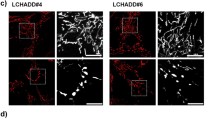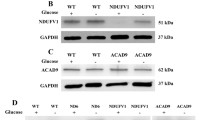Summary
We have compared respiratory chain enzyme activities, ATP synthesis, and ATP hydrolysis in cultured fibroblast mitochondria from patients with Leigh syndrome (LS) due to: (i) cytochrome oxidase (COX) deficiency (#6); (ii) pyruvate dehydrogenase complex (PDHC) deficiency (#4); and (iii) maternally inherited LS (MILS) with the T8993G mutation in the ATPase 6 gene of mtDNA (#5). Enzyme activities were normal in patients with MILS and variably decreased in those with COX and PDHC deficiency. ATP hydrolysis was normal or mildly decreased in all three groups. In contrast, ATP synthesis was decreased in all patients but more markedly in those with MILS, and especially with pyruvate/malate as substrate. These studies show that impaired ATP production is the common feature of all three forms of LS, but it is both more severe and more specific in MILS, consistent with the genetic defect.
Similar content being viewed by others
References
Anderson S, Bankier, AT, Barrell BG, et al (1981) Sequence and organization of the human mitochondrial genome.Nature 290: 457–465.
Arts FWM, Scholte HR, Loonen MCB (1987) Cytochromec oxidase deficiency in subacute necrotizing encephalopathy.J Neurol Sci 77: 103–115.
Davis PC, Hoffman JC, Braun IF, Anmann P, Krawiecki N (1987) MR of Leigh's disease (subacute necrotizing encephalopathy).Am J Neurol Res 8: 71–75.
DiMauro S, Servidei S, Zeviani M, et al (1987) Cytochromec oxidase deficiency in Leigh syndrome.Ann Neurol 22: 498–506.
Holt IJ, Harding AE, Petty RKH, Morgan-Hughes JA (1990) A new mitochondrial disease associated with mitochondrial DNA heteroplasmy.Am J Hum Genet 46: 428–433.
Kretzschmar HA, DeArmond SJ, Koch TK, et al (1987) Pyruvate dehydrogenase complex deficiency as a cause of subacute necrotizing encephalopathy (Leigh's disease). Pediatrics 79: 370–373.
Millis AJT, Pious DA (1973) Oxidative phosphorylation in mitochondria isolated from human fibroblasts.Biochim Biophys Acta 292: 73–77.
Miranda AF, Ishii S, DiMauro S, Shay JW (1989) Cytochromec oxidase deficiency in Leigh's syndrome: genetic evidence for a nuclear DNA-encoded mutation.Neurology 39: 697–702.
Montpetit VJA, Anderman F, Carpenter S, Fawcett JS, Zborowska-Sluis D, Gibersun HR (1971) Subacute necrotizing encephalopathy: a review and a study of two families.Brain 94: 1–30.
Old SE, DeVivo DC (1989) Pyruvate dehydrogenase complex deficiency: biochemical and immunoblot analysis of cultured skin fibroblasts.Ann Neurol 26: 746–751.
Palva TK, Palva ET (1985) Rapid isolation of animal mitochondrial DNA by alkaline extraction.FEBS Lett 192: 267–270.
Pincus JH (1972) Subacute necrotizing encephalomyelopathy (Leigh's disease): a consideration of clinical features and etiology.Dev Med Child Neurol 14: 87–101.
Pullman ME, Penefsky HS, Datta A, Racker E (1960) Partial resolution of the enzymes catalizing oxidative phosphorylation. I: Purification and properties of soluble dinitrophenol-stimulated adenosine triphosphatase.J Biol Chem 235: 3322–3329.
Robinson BH (1988) Cell culture studies on patients with mitochondrial diseases: molecular defects in pyruvate dehydrogenase.J Bioenerg Biomembr 20: 313–323.
Robinson BH, Ward J, Goodyer P, Baudet A (1986) Respiratory chain defects in the mitochondria of cultured skin fibroblasts from three patients with lacticacidemia.J Clin Invest 77: 1422–1427.
Santorelli FM, Shanske S, Macaya A, DeVivo DC, DiMauro S (1993) The mutation at nt 8993 of mitochondrial DNA is a common cause of Leigh's syndrome.Ann Neurol 34: 827–834.
Tatuch Y, Christodoulou J, Feigenbaum A, et al (1992) Heteroplasmic mtDNA mutation (T>G) can cause Leigh disease when the percentage of abnormal mtDNA is high.Am J Hum Genet 50: 852–858.
Tatuch Y, Robinson BH (1993) The mitochondrial DNA mutation at 8993 associated with NARP slows the rate of ATP synthesis in isolated lymphoblast mitochondria.Biochem Biophys Res Commun 192: 124–128.
Tuena de Gomez-Puyou M, Ayala G, Darszon A, Gomez-Puyou A (1984) Oxidative phosphorylation and the Pi-ATP exchange reaction of submitochondrial particles under the influence of organic solvents.J Biol Chem 259: 9472–9478.
Van Coster R, Lombes A, DiMauro S (1991) Cytochromec oxidase-associated Leigh syndrome: phenotypic features and pathogenic speculations.J Neurol Sci 104: 97–101.
Zeviani M, Peterson P, Servidei S, Bonilla E, DiMauro S (1987) Benign reversible muscle cytochromec oxidase deficiency.Neurol 37: 64–67.
Author information
Authors and Affiliations
Rights and permissions
About this article
Cite this article
Vazquez-Memije, M.E., Shanske, S., Santorelli, F.M. et al. Comparative biochemical studies in fibroblasts from patients with different forms of Leigh syndrome. J Inherit Metab Dis 19, 43–50 (1996). https://doi.org/10.1007/BF01799347
Received:
Accepted:
Issue Date:
DOI: https://doi.org/10.1007/BF01799347




